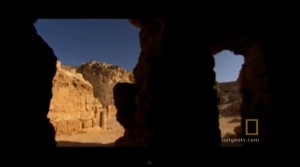How fortunate for Herod that his name wasn’t Jesus
The Israel Museum announced that starting February 12, 2013 the museum is going to put on display a giant “King Herod” exhibition. This will involve 30 tons of artifacts. Herod the Great is the museum’s largest and most expensive archaeological project to date.
Before his untimely accidental death in 2010 at Herodium – where he excavated for 35 years – archaeologist Ehud Netzer z”l announced that he had discovered the long lost tomb of Herod the Great. Part of the museum’s exhibition will involve the remains of this tomb. These include some columns and three smashed up sarcophagi which were found at the site. I believe that Netzer, who I had the honour of knowing, did correctly locate Herod the Great’s tomb. Having said this, the evidence is very flimsy; no complete sarcophagus, no inscriptions, only pieces of a sarcophagus that seems to have been made of a special reddish stone. It was found smashed into hundreds of fragments! And yet, curator Dudi Mevorah from the Israel Museum says that “the circumstantial evidence points to one man” i.e., Herod the Great. His good friend, social anthropologist Joe Zias, an expert on Afro-American music, who retired from the Israel Antiquities Authority some ten years ago, is also convinced that this is Herod the Great’s tomb. I don’t exactly know what Zias’ expertise is when it comes to Herod the Great, but Zias has been quoted as stating “it’s as authentic as one could ask for”. Remember, no tomb, no coffins, no inscriptions, no bones, no symbols, no drawings, only three sarcophagi smashed into hundreds of pieces, some of which seem to be reddish. How fortunate for Herod that his name wasn’t Jesus.
In contrast, in the Talpiot suburb of Jerusalem, in 1980 a tomb was found that is still perfectly intact. In it were perfectly intact ossuaries (bone boxes). More than this, there are perfectly legible names inscribed on the ossuaries. One states, “Jesus, son of Joseph”. Another states, “Maria”. And another bears the nickname of one of Jesus’ brothers, “Josi” or “Yose” in Aramaic. Then for kickers there is an inscription on an ossuary that bears the name – in Greek – “Mariamene”. In the entire body of Greek literature, the particular spelling of this name is associated with only one woman, Mary Magdalene! Not only that; on the Jesus ossuary there is a cross just ahead of his name. Not only that; on the lid of the Jesus ossuary there is a star – yes, a star!
60 meters away from this tomb there is another tomb. Also perfectly intact. In it were found perfectly intact ossuaries. On one of them there is an inscription of faith unique to the corpus of inscriptions which were found on over 3,000 ossuaries. It seems to have something to do with belief in resurrection – yes, resurrection. Not only that; but on another ossuary there is the earliest symbol of Christianity – the “sign of Jonah”. The “sign” is mentioned in the gospels themselves and is found over a hundred times in the catacombs of Rome, associated only with the followers of Jesus. In case some future naysayers might doubt that this is the sign of Jonah, the man who inscribed the image of a fish spitting out the prophet Jonah wrote in the head of the fish the word “Yonah”. It’s a kind of ancient subtitle. But, alas, the very same people who think that three smashed up sarcophagi add up to Herod, don’t think that the intact ossuaries with their intact inscriptions add up to Jesus.
The argument goes like this:
1. Jesus isn’t that Jesus. It’s another Jesus.
2. Maria isn’t the mom. It’s a common name.
3. Yose isn’t the brother. It’s also a common name.
4. Mariamene isn’t Mary Magdalene. The authoritative Rahmani who published the unique spelling of the name made a mistake. He’s human. The new reading renders the name more common. It’s just another Mary.
5. The cross isn’t a cross. It’s just an “X”. A stone mason’s mark.
6. The star is just a star. Lots of people have stars.
7. The declaration of resurrection faith isn’t a declaration of faith at all. It’s a warning against moving bones.
8. The sign of Jonah isn’t a sign of Jonah. The fish is a vase and the stick figure is nothing and the name “Yonah” on top of it all isn’t really “Yonah,” it says “Zila”. It’s basically the ossuary of a woman with the previously unheard of name “Zila” who had a favourite vase on which she had her name scratched. She was buried next to a guy who was a Jesus, but not that Jesus, who had Marys in his life, but not those Marys.
Now let’s talk about Herod. I can’t wait to see those smashed up sarcophagi.


